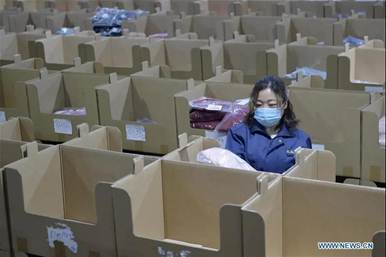编语:在当前,众志成城、抗击疫情的时刻,研究院积极行动,积极发声,贡献智慧。这其中也不乏来自国际的声音。此前,国际友人针对此次疫情从不同角度发表了个人看法,为促进全球共同抗击疫情,抵御疫情对全球的冲击贡献智慧。
近日,新加坡国立大学李光耀公共政策学院教授、广东国际战略研究院国际客座研究员顾清扬接受采访时表示,新冠肺炎疫情对全球供应链产生了巨大的影响,为了在未来保持竞争力,中国应致力于建立强大的本地工业供应链,以及更多的区域供应链,以增强应对新冠肺炎危机的能力。就目前而言,中国作为经济中心仍然具有吸引力,但这种吸引力能否持续,取决于中国是否有能力深化改革,并采用国际最佳做法以创造良好的商业环境。
专家介绍:
顾清扬,新加坡国立大学李光耀公共政策学院教授、广东国际战略研究院国际客座研究员

文章来源:
Chinadaily
China should focus on building strong local industrial supply chains, as well as more regional supply chains, to become more resilient after the COVID-19 crisis, a leading Singapore economist said.
Gu Qingyang, an associate professor at the Lee Kuan Yew School of Public Policy at the National University of Singapore, said in a recent interview that the COVID-19 epidemic had greatly impacted the world's global supply chains.

A worker arranges cashmere sweaters at a cashmere product manufacturing company in Qinghe county, North China's Hebei province, April 30, 2020. China accounts for 30 percent of the added value of the world's manufacturing industry. [Photo/Xinhua]
In the direct aftermath, the outbreak caused China's economy to shut down, and when Northeast Asia, Europe and the United States became the epicenter of the outbreak, the disruption of supplies further slowed China's economic recovery, he said.
With the economic shocks, the layout of global supply chains will likely see a major change in the future, striking a "new balance between cost savings and supply chain resilience". While the focus was on low cost locations in the past, it is likely that countries will put greater emphasis on boosting the overall security and resilience of the supply chain, said Gu.
To remain competitive in the future, China first needs to work on building a "longer and more complete" local industrial and supply chain, Gu said.
China accounts for 30 percent of the added value of the world's manufacturing industry and it is unlikely that a mass exodus of multinational companies will leave China in the short term, he added.
With a more localized economy and supply chain, the greater the cost savings and efficiency will be as a result of companies and industries clustering together, he explained.
Secondly, China still needs to decentralize its distribution regionally to form a "multi-dimensional" industrial chain and supply chain system, such as by working with Northeast and Southeast Asia, Gu said.
It also should continue to expand its global presence by building supply chains with Europe and the United States "as much as possible", integrate industries and supply chains, and extend its infrastructure and construction projects in countries involved in the Belt and Road Initiative, he said.
Gu also outlined three different models for future supply chains - the first one being a complete localization of the supply chain.
However, given the complexity of today's products, with tens of thousands of component parts, it is difficult to find a country with a global comparative advantage with the production of all these components. Too much emphasis on a localized industrial chain would drive production costs, hurt its global competitiveness and affect a country's ability of risk diversification, especially if the next crisis occurs at any moment, Gu said.
A regional supply chain with production being clustered within several countries near each other would enjoy a shorter distance between producers and demand, save on logistics costs and reduce carbon emissions, but may not be as resilient.
In the case of the European Union's single market, it led to a "beggar-thy-neighbor" scramble in the distribution of masks, suggesting that supply chains in neighboring regions are "unreliable in the face of a big crisis," the professor said.
The third approach would still center on global distribution, but comprehensively weighs factors like cost savings, corporate ecosystems and the resilience and security of the supply chain, Gu said.
"The original over-concentrated supply chain and the over-emphasis on zero inventory needs to be adjusted…. And the risk management of the overall supply chain (should place less priority) on cost savings to maintain resilience in a crisis," Gu said.
For now, China still remains attractive as an economic hub, but whether this can be sustained depends on its ability to deepen reform and adopt international best practices to create a favorable business environment.
